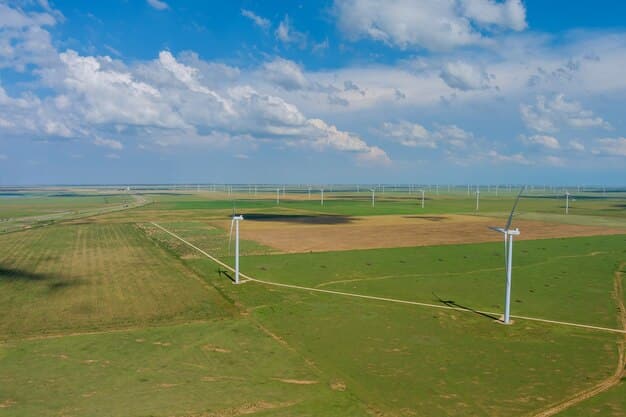How the Infrastructure Bill’s $7.5B for EV Charging Impacts US Auto Industry

Decoding the Impact of the Infrastructure Bill’s $7.5 Billion Investment in Electric Vehicle Charging Stations on the US Auto Industry reveals a multifaceted transformation, from accelerating EV adoption and reshaping manufacturing to fostering job creation, reducing emissions, and creating new business opportunities.
The Decoding the Impact of the Infrastructure Bill’s $7.5 Billion Investment in Electric Vehicle Charging Stations on the US Auto Industry represents a pivotal moment, poised to reshape the automotive landscape for decades to come. How exactly will this investment impact car manufacturers, consumers, and the environment?
Understanding the Infrastructure Bill’s EV Charging Investment
The Infrastructure Investment and Jobs Act, signed into law, allocates a significant $7.5 billion to expand the electric vehicle (EV) charging infrastructure across the United States. This investment aims to address range anxiety, encourage EV adoption, and support the growth of the US auto industry.
What Does the Investment Entail?
The $7.5 billion earmarked for EV charging is strategically divided. A significant portion is dedicated to establishing a national network of EV chargers, prioritizing rural and underserved communities. This initiative aims to ensure that EV charging is accessible to all Americans, regardless of their location.
- National EV Charging Network: Funding will support installing fast-charging stations along major transportation corridors.
- Community Charging Grants: Grants target local communities to deploy charging infrastructure in residential areas, schools, and public parking lots.
- Manufacturing Incentives: A portion of the investment is allocated to bolster domestic manufacturing of EV chargers and related components.
Beyond infrastructure development, the bill also supports research and development into advanced charging technologies, grid modernization, and workforce training programs. This multifaceted approach seeks to create a robust and sustainable EV ecosystem.
In summary, the EV charging investment within the infrastructure bill is a comprehensive plan that addresses infrastructure gaps, promotes equitable access, and stimulates innovation in the EV sector.

Impact on Electric Vehicle Adoption Rates
One of the most immediate and direct consequences of the infrastructure bill’s EV charging investment is its potential to accelerate the adoption of electric vehicles among US consumers. Increased availability of charging stations should significantly boost consumer confidence in EVs.
Alleviating Range Anxiety
Range anxiety, the fear of running out of battery power before reaching a charging point, remains a significant barrier to EV adoption for many potential buyers. By expanding the charging infrastructure, particularly in rural areas and along highways, the bill directly addresses this concern.
- Expanded Charging Network: More charging stations mean drivers can travel longer distances without worrying about running out of power.
- Faster Charging Technologies: Investment in fast-charging stations reduces charging times, making EVs more convenient for long trips.
- Real-Time Information: Improved availability of information on charging stations through mapping apps and navigation systems.
The investment is also expected to drive down the cost of EV ownership. As demand for EVs increases, manufacturers will likely scale up production, leading to lower prices. Government incentives and tax credits, combined with reduced operating costs (lower fuel and maintenance expenses), will make EVs an attractive option for a broader range of consumers.
Ultimately, the EV charging investment should help to normalize electric vehicles, making them a practical and reliable choice for everyday transportation needs.
Reshaping the US Auto Manufacturing Landscape
The infrastructure bill’s EV charging investment prompts significant changes in the US auto manufacturing landscape. Automakers must shift their focus toward electric vehicle production to meet the rising demand, thus boosting investment in new manufacturing strategies.
Transitioning to EV Production
As EV adoption rates climb, automakers are compelled to invest heavily in retooling their factories and developing new EV models. This transition requires significant capital investments, technological innovations, and workforce training programs.
Some major automotive manufacturers are increasing investment in EV technology.
- Factory Investments: Automakers are building new factories and converting existing ones to manufacture EVs and batteries.
- Research and Development: Significant funds are allocated to research and development of advanced battery technologies, electric drivetrains, and autonomous driving systems.
- Supply Chain Development: Automakers are working to secure their supply chains for critical components, such as batteries, semiconductors, and rare earth materials.
The bill’s focus on domestic manufacturing also encourages automakers to localize their supply chains, creating new jobs and strengthening the US economy. This shift could lead to the resurgence of manufacturing in regions that have experienced economic decline.
Automakers that are able to successfully navigate this transition will be well-positioned to thrive in the rapidly evolving automotive market. Those who lag behind risk losing market share and falling behind their competitors.
Job Creation and Economic Opportunities
The infrastructure bill’s EV charging investment promises to generate numerous job creation opportunities and stimulate economic growth across various sectors. These opportunities span manufacturing, construction, technology, and service industries.
Manufacturing Jobs
Expanding EV production and charger manufacturing in the US will directly create new jobs in manufacturing plants, component suppliers, and related industries. These jobs often offer competitive wages and benefits, helping to bolster the middle class.
Here are some manufacturing jobs that might emerge:
- EV Assembly Line Workers: Assembling electric vehicles and related components.
- Battery Manufacturing Technicians: Producing and assembling EV batteries.
- Charger Manufacturing Specialists: Manufacturing EV charging equipment.
The construction of EV charging stations also creates jobs for electricians, construction workers, and technicians. These skilled trades are essential for installing, maintaining, and upgrading the charging infrastructure.
Furthermore, a thriving EV ecosystem requires a skilled workforce to provide maintenance, repair, and customer support services. This creates new opportunities for technicians, service advisors, and customer service representatives.
Reducing Emissions and Environmental Impact
A key objective of the infrastructure bill’s EV charging investment is to reduce greenhouse gas emissions and mitigate the environmental impact of transportation. By incentivizing the adoption of electric vehicles, the bill aims to create a cleaner, more sustainable transportation system.

Transitioning to Sustainable Energy
Electric vehicles produce zero tailpipe emissions, meaning they do not directly release pollutants into the atmosphere. When powered by renewable energy sources, such as solar or wind, EVs can significantly reduce the carbon footprint of transportation.
Here’s how transitioning to EVs can help reduce environmental impact:
- Lower Greenhouse Gas Emissions: EVs powered by renewable energy sources significantly reduce greenhouse gas emissions compared to gasoline-powered vehicles.
- Improved Air Quality: Zero tailpipe emissions from EVs improve air quality in urban areas, reducing respiratory illnesses and other health problems.
- Reduced Dependence on Fossil Fuels: Increased EV adoption reduces the nation’s dependence on fossil fuels, promoting energy independence and security.
The bill also supports the development of smart grid technologies, which can optimize the distribution of electricity and enable more efficient charging of EVs. This can help to reduce the strain on the grid and ensure that EVs are powered by the cleanest energy sources available.
In essence, the EV charging investment is a crucial step toward creating a cleaner, more sustainable transportation system that benefits both the environment and public health.
New Business Models and Opportunities
The expansion of EV charging infrastructure creates new business models and opportunities for entrepreneurs, investors, and established companies. These opportunities span various sectors, including charging station operation, software development, and energy management.
EV Charging Station Operations
The operation of EV charging stations can be a profitable business, particularly in high-traffic areas and along major transportation corridors. Companies can generate revenue through charging fees, advertising, and partnerships with local businesses.
Here are some models companies can use:
- Charging Station Networks: Companies can develop and operate networks of charging stations, offering a range of services to EV drivers.
- Charging as a Service: Companies can offer charging services to businesses and organizations, providing turnkey solutions for EV charging infrastructure.
- Smart Charging Solutions: Companies can develop software and hardware solutions that optimize charging schedules, manage energy consumption, and integrate with the grid.
The infrastructure bill also encourages collaboration between public and private sectors, creating opportunities for partnerships between government agencies, utilities, and private companies. These partnerships can help to accelerate the deployment of EV charging infrastructure and ensure that it is accessible to all communities.
Overall, the EV charging investment is a catalyst for innovation and entrepreneurship, creating new opportunities for businesses to thrive in the emerging EV ecosystem.
| Key Point | Brief Description |
|---|---|
| ⚡ EV Adoption | More charging stations reduce “range anxiety,” boosting EV adoption. |
| 🏭 Auto Manufacturing | Forces automakers to ramp up EV production and innovate rapidly. |
| 💼 Job Creation | Creates jobs in manufacturing, construction, and tech sectors. |
| 🌍 Emission Reduction | Promotes cleaner transportation and fewer emissions. |
Frequently Asked Questions
▼
The bill allocates $7.5 billion to expand EV charging infrastructure, focusing on deploying fast-charging stations along major corridors and in communities.
▼
By alleviating range anxiety and reducing charging times, the investment is expected to encourage broader EV adoption among consumers.
▼
Automakers are being driven to shift toward electric vehicle production, investing in new factories, technologies, and battery production.
▼
The investment will generate jobs in manufacturing, construction, technician roles, and in operations related to EV charging stations.
▼
By supporting the transition to electric vehicles, the initiative aims to significantly reduce greenhouse gas emissions and dependency on fossil fuels.
Conclusion
The Infrastructure Bill’s $7.5 billion investment in electric vehicle charging stations is a transformative step for the US auto industry. From accelerating EV adoption and reshaping manufacturing to creating jobs and reducing emissions, the initiative paves the way for a more sustainable and economically robust future.





